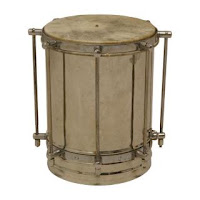Samba Batucada
· Batucada is a sub-style of the Samba that is an African influenced Brazilian percussive style. It is a percussion ensemble. The Batucada is well known for its repetitive rhythms and its fast tempo
o Repinique: high-pitched tom-tom
o Surdo: large drum with 50cm diameter. It is the bass drum that provides the downbeat of the rhythm
o Tamborim: small drum played with a stick
o Bells: Cowbell and Agogo bells
o Maracas
o Caixa: a thin snare drum
o Cuica: single headed drum with a stick mounted inside the drum body. It is played by rubbing a damp cloth along the stick while pressing the head of the drum with a finger. The closer to the stick the finger is pressed, the higher pitched sound is produced. the Cuica can often sound like a human voice
o Timba: a long drum that produces low tones. Played with one hand on the head of the drum and one hand beating the body of the drum
o Pandeiro: similar to a tambourine but it can be tuned. played using the hand, just like a tambourine
o Reco-Reco: a hollow wooden instrument with a ridged surface that is scraped with a stick. It is more commonly known as the Guiro
o Apito: a small wooden whistle
 |
| Tamborim |
 |
| Caixa |
 |
| Reco-Reco |
 |
| Timba |
 |
| Surdo |
 |
| Agogo Bells |
 |
| Cowbell |
Samba Batucada Performers:
o Rhythms of Resistance
o Saraganhad
o Francisco Lopez
o Mestre Hector Alexander
Rhythms of Resistance








